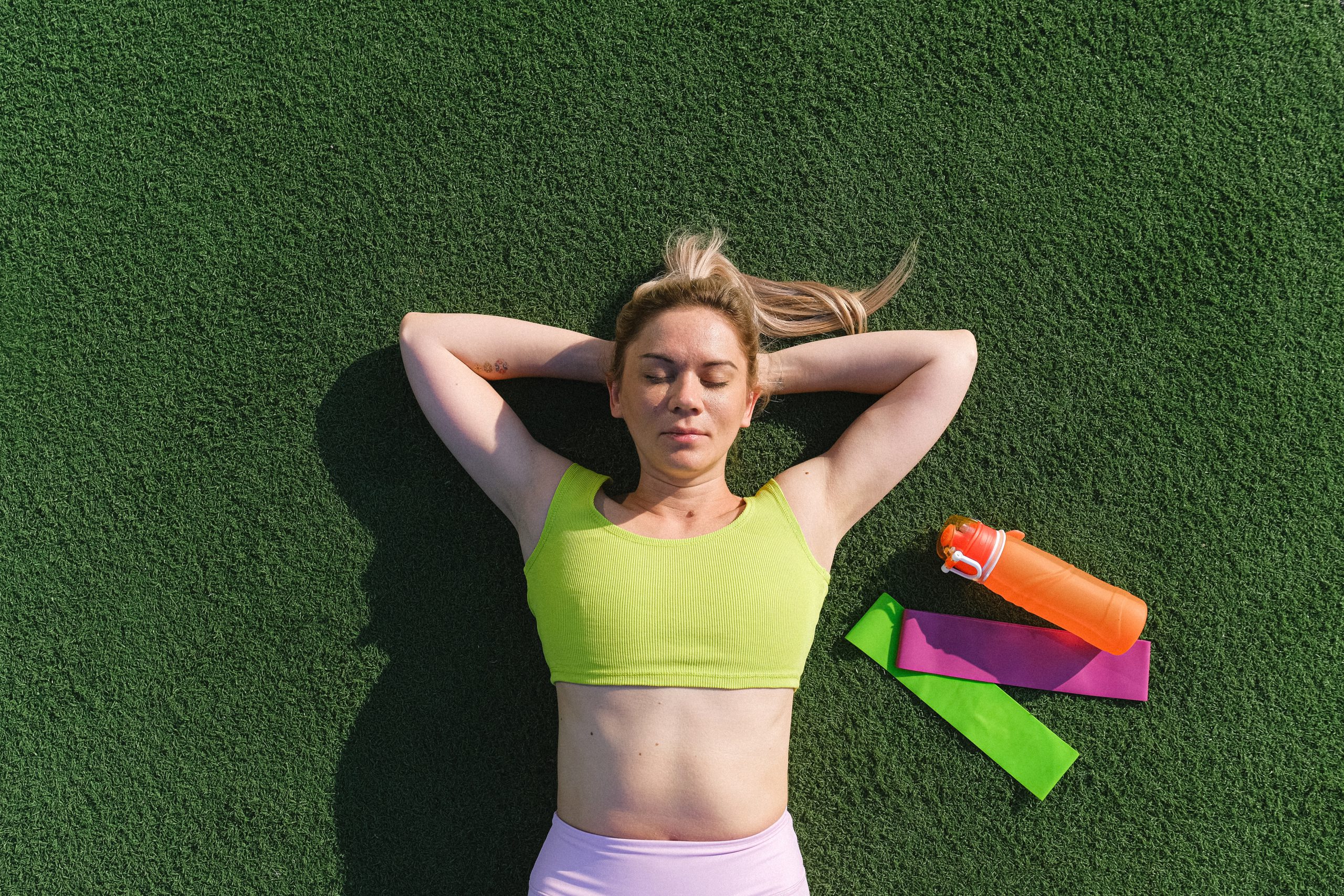Has the arrival of spring also motivated you to exercise outdoors? With these 5 tips, you can enjoy your outdoor workout even more! Regular exercise is generally a gift to your health. Research into the benefits of outdoor exercise suggests that your health can benefit even more from physical activity in the open air (1). Outdoor exercise is said to be particularly beneficial to your mental well-being and, for example, can positively influence your mood (2).
Exercising in a natural environment is also an excellent way to reduce stress. Participants in the research into the benefits of outdoor exercise reported that they were more likely to repeat their workouts regularly than if they had to do them indoors (3). And it is precisely this regularity that you need to take full advantage of the benefits that physical exercise can offer. It is the repetition that leads to better physical fitness and stronger muscles. Would you also like to exercise outdoors this spring? With these 5 tips, you can make the most out of your outdoor workout!
1. Don’t dress too warmly when exercising outside
Exercising outside becomes a lot more enjoyable when you wear the right clothing. When you step outside, the outdoor air can sometimes feel chilly. However, as soon as you start moving, you’ll quickly notice that your body warms up. A little bit of sweating is normal, but if you sweat unnecessarily, it can detract from your enjoyment of the workout. Damp clothing doesn’t feel pleasant and restricts your freedom of movement. Therefore, don’t dress too warmly when exercising outside. Are you unsure about the right outfit and do you have the opportunity to take something off halfway through your workout? Then opt for thin layers. If you’re going for a workout where you won’t sweat much, such as gentle yoga in the park, natural materials such as organic cotton are very suitable. Tencel (or lyocell) and modal are also nice and airy. If you’re planning a cardio workout and will be exerting yourself heavily, there’s a greater chance that you’ll sweat profusely. In that case, materials that wick moisture away from your skin and/or dry quickly are often more comfortable. Cotton can become very damp and feel heavy and sticky. Tencel dries a bit faster than cotton. Synthetic materials such as polyester or nylon are often used for sportswear because they wick away your sweat even better. Would you prefer a natural material that can also wick moisture away well? Try thin merino wool. It absorbs moisture excellently and won’t feel wet on your skin when you sweat.
2. Start with a proper warm-up when exercising outdoors
A proper warm-up is always important, whether you’re working out indoors or outdoors. When you exercise outside on cooler days, it’s especially important to warm up your muscles beforehand. Spend at least 5 to 10 minutes warming up and stretching your muscles. Research has shown that warming up before exercise can significantly reduce the risk of injury (4).
Stretching can also improve your flexibility and give you a sense of freer movement. Additionally, warming up promotes blood flow and oxygen transport. Results of another study suggest that warming up properly before exercise can also improve your performance (5). Another benefit of a good warm-up is a lower risk of muscle soreness, which may increase your motivation to exercise outside again soon!

3. Take it easy when starting to exercising outdoors
If you want to enjoy outdoor sports this spring but haven’t been very physically active lately, it’s important to build up slowly. While motivation is great, pushing yourself too hard can quickly lead to burnout. Give yourself time to build up your fitness level gradually so that you don’t become completely exhausted and discouraged. Taking it slow when starting out also reduces the risk of muscle and joint injuries. If you have a specific goal in mind, such as participating in a half marathon later in the year, you can easily create a training schedule to build up your endurance. Start with the date when you want to achieve your goal and work backward step by step to the present. This will help you determine how many kilometers you need to start with and when to gradually increase your distance. Be realistic in your goals and ask an expert for help if you’re unsure about what your body can handle. By doing so, you can avoid disappointment and make outdoor sports a fun and healthy activity!
4. Drink enough water
Drinking enough water is always important when you exercise. If you’re exercising outdoors, especially in warm or sunny weather, staying hydrated is even more crucial. Drinking enough water before, during, and after exercise can help prevent overheating and heatstroke. When you’re well-hydrated, you can easily sweat, which helps your body get rid of excess heat. But water does much more for your body than regulating your body temperature. Drinking enough water also helps with:
• keeping your joints lubricated
• digesting food
• removing waste products
• transporting nutrients via your blood
• protecting your brain and spine from shock
All the more reason to always have a bottle of water with you! If you want to support your sports performance with the right nutrition, check out this article about what to eat and drink before, during, and after exercising. Sapje also offers special juices and smoothies for athletes, such as the protein smoothie, the hydrate juice, and the recover juice. Delicious, natural, and healthy!

5. Keep outdoor sports enjoyable for yourself
As mentioned before, outdoor exercise can bring many additional benefits that make it more enjoyable than indoor exercise. You can get a better mood and more energy from exercising in the fresh air. Perhaps you also enjoy it more because of the beautiful surroundings, sunlight, and fresh wind on your skin. However, you may also become accustomed to it after a while. Then it may be necessary to ensure that outdoor exercise remains enjoyable. Variation is an important factor here. For example, if you go cycling, walking, or running, choose a different route occasionally, so you can see something new. Or choose a different workout than usual and try a circuit training or a HIIT workout. The article ‘5 workouts for outdoors‘ gives you more inspiration for different workouts you can do outside. The right company can also make outdoor exercise more enjoyable. Maybe a friend, family member, or fun colleague wants to join you!
Don’t be too hard on yourself, but also challenge yourself enough to ensure that outdoor exercise remains enjoyable. A workout buddy can help with that too. Sports with a game element that you can also do in larger teams can also promote your enjoyment of sports. Think of playing football or basketball outside, or try beach volleyball or frisbee. The more fun you have with outdoor exercise, the more likely you are to keep doing it!
Sources:
- Gladwell, V., Brown, D. G., Wood, C., Sandercock, G., & Barton, J. (2013). The great outdoors: how a green exercise environment can benefit all. Extreme physiology and medicine, 2(1). https://doi.org/10.1186/2046-7648-2-3
- Bowler, D. E., Buyung-Ali, L. M., Knight, T. M., & Pullin, A. S. (2010). A systematic review of evidence for the added benefits to health of exposure to natural environments. BMC Public Health, 10(1). https://doi.org/10.1186/1471-2458-10-456
- Coon, J. T., Boddy, K., Stein, K., Whear, R., Barton, J. S., & Depledge, M. H. (2011). Does Participating in Physical Activity in Outdoor Natural Environments Have a Greater Effect on Physical and Mental Wellbeing than Physical Activity Indoors? A Systematic Review. Environmental Science & Technology, 45(5), 1761–1772. https://doi.org/10.1021/es102947t
- LaBella, C. R., Huxford, M. R., Grissom, J. E., Kim, K., Peng, J., & Christoffel, K. K. (2011). Effect of Neuromuscular Warm-up on Injuries in Female Soccer and Basketball Athletes in Urban Public High Schools. Archives of pediatrics & adolescent medicine, 165(11), 1033. https://doi.org/10.1001/archpediatrics.2011.168
- Fradkin, A., Zazryn, T. R., & Smoliga, J. M. (2010). Effects of Warming-up on Physical Performance: A Systematic Review With Meta-analysis. Journal of Strength and Conditioning Research, 24(1), 140–148. https://doi.org/10.1519/jsc.0b013e3181c643a0

